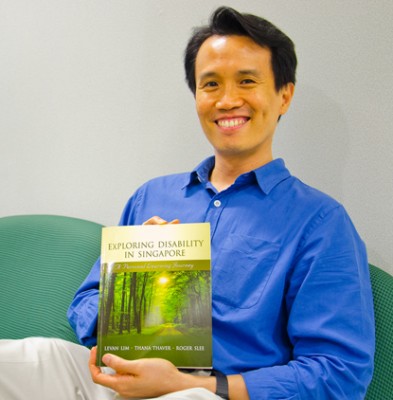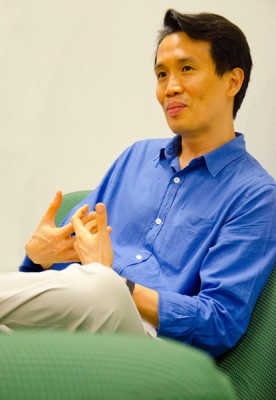Why Singapore’s English Teachers Should Embrace Singlish, Not Fight It
Is it time for Singaporean educators to embrace Singlish as a legitimate learning tool? What the Research […]
Read More
Inclusion isn’t just about people with special needs – it’s for everyone. Levan Lim believes that if we could all have personal experiences with people who are different from ourselves, we will become a more humane society.

In 2004, the Prime Minister announced a vision of an inclusive society. This vision explicitly includes people with special needs and disabilities.
In order to have an inclusive heart, an inclusive disposition, an inclusive attitude towards people with special needs, it’s important for people in general to gain some kind of personal, practical knowledge and experience.
We’ve all grown up in a society where traditionally there’s been a dual system of education – where people without disabilities go to mainstream schools and people with special needs go to special schools.
I think it’s important for schools to promote the inclusion of kids with special needs within their settings. Once you have kids with special needs interacting with kids without special needs, what happens is those kids without special needs start gaining the personal, practical experience and knowledge.
And if we’re going to have an inclusive community in the future, schools need to be microcosms of the kind of community that’s envisioned in the future. The seeds of inclusion need to be planted in the young so that they will learn the values, skills and knowledge to include others who are different from them. That’s the basis of our future society.
Now, to inculcate these in the students, the teachers themselves need to model and display those attitudes which we would like to see within the young. And for that to happen, teachers themselves need to be taught to become more inclusive.
It’s really about looking at their own attitudes. What we try to do at NIE is create that space within our classes for them go within and to look at those attitudes which may expose them to being maybe a bit prejudiced. We try to create a safe space for them to, in a way, expose their vulnerability.
– Levan Lim, Early Childhood and Special Needs Education Academic Group
It’s not just about skills and knowledge; it’s also linked to your own personhood, your own values as a human being. And that’s an important part of their journeying at NIE. Because it’s easy to build the hardware – the ramps, the lifts, the buildings – to make Singapore and Singaporean schools more inclusive. But the harder part is the software – the people – and that requires a lot of work, the “heartware”.
Our approach at NIE is never commanding; it’s always invitational. We invite them to journey within and to journey with other people – their friends, their classmates – and to listen to each other’s journeys, and to re-story it after their have heard it in a more positive way towards the future.
The first part is just to be real, be open, be honest with yourself. That’s what we’re asking of them in their classes – to be honest with yourself, to look at yourself, to look at your upbringing, to look at how the social context has socialized you to not have those experiences, and to slowly gain them through being open to children who are different. I think that honesty, that openness is extremely important. So, we start with that.
But that can leave the teacher a bit vulnerable, because you’re actually sharing a part of you which you may not want to share, because it could expose prejudice. So we ask them to accept those feelings and thoughts about themselves. You really have to accept yourself first – all your vulnerabilities, your strengths, your weaknesses – and then from there move on. That requires a posture of openness, honesty, and acceptance of self.
When I was a doctoral student, I started asking: What are the best safeguards for people with disabilities in society? And if you think about it, the best safeguards for people with disabilities would probably be the same for all of us when we get weaker and older – it’s really about circles of support and relationships with people who care.

The key is, really, how do we increase the community’s capacity to look after people with special needs? Because ultimately, I think we believe that people with special needs belong within communities. It’s not about getting professionals to look after them all the time. It’s also getting regular people to are for them and be with them.
I guess it also goes back to my experiences. I grew up with my cousin who had special needs. Having that personal, practical knowledge as a child growing up, I know it’s so natural for a child to just include someone who’s different.
And that’s something that should be an opportunity for many Singaporeans, rather than sending them away to live with other communities, or other institutions, other homes, or other schools. Why can’t we include them within our regular communities?
Social cultural theory suggests that it is important to look at difference as something that you can make a difference about. Difference that makes a difference.
If we can just extend that whole notion also to special needs. Living, playing, like how I did with my cousin, it becomes part of your emotional, material, semiotic world. Because that’s how you see life – it’s coloured by the experiences. If you separate these kids and put them in special schools, and not bring them into the mainstream schools, then I think society is less the richer.
So, to me, inclusion is about life. Inclusion is not about people with special needs; inclusion is about everyone, including everyone. And caring! Because the ideas of caring, support, love and warmth – they’re not just exclusive for people with special needs. They’re for everyone, and we treat people everywhere that way – that’s what inclusion’s about. It’s really for everyone.